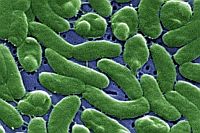
Vibrio vulnificus (CDC/James Gathany)
Is it safe to go into the water? Officials with the Florida Department of Health are warning that vibro vulnificus, a flesh eating bacteria, poses a threat to those who eat uncooked seafood or go into the state ocean water with cuts or open wounds. Those with compromised immune systems are at the greatest risk of infection. Vibrio vulnificus is a bacterium found in all warm coastal waters of the United States. This year, 12 cases have been identified by health officials, including 3 fatalities. In 2013, Florida reported 41 cases and 11 deaths from the bacteria.
To put this into context, there were no fatal shark attacks in Florida in 2013. The last reported shark fatality in the state was in 2005. In the more than 130 years between 1882 and 2013, there have been a total of 11 confirmed deaths from shark attacks in the state of Florida, as compared to 11 deaths from vibro vulnificus infection in the year 2013, alone. Vibro vulnificus is many times more dangerous than sharks.
As reported by the UPI: Vibrio vulnificus is a relative of the bacterium that causes Cholera. If swimmers ingest infected salt water, the bacterium can cause stomach pain, vomiting and diarrhea. But it is most dangerous when it invades the skin via open wounds, which can lead to “skin breakdown and ulceration,” according to the CDC.
Most infections are successfully treated with a course of antibiotics, but severe skin infections can result in amputation; and for those with weakened immune systems, the infections can prove fatal.
Unfortunately, Florida tests the water quality at only 41% of its beaches.

Read that, not surprised.
We have poison algae in Lake Erie, the catch basin for the 3 above us.
You can’t touch it without getting sick.
A few years ago I walked down to the pier, out on the rocks. Water slpashed on my arm, about two weeks later I was hurting and didn’t know it. When I finally went to the doc, I had Pneumonia. Thankfully there was antibiotics.
V. vulnificus remains a high risk in warm salty water for a couple of reasons: while oyster beds are routinely sampled for coliform bacteria which indicates fecal contamination of the beds, Vibrios, naturally occurring halophilic bacteria are not.
To refer to vibrios as a “flesh eating bacterium” is a stretch as that label is used to refer to certain strains of antibiotic resistant Staphylococcus bacteria that cause lesions on the skin surface. Vibrios present the greatest danger to those who are either immunocompromised or have liver disease and is most often caused by eating raw oysters from beds where the salt water is unusually warm as in southern oyster beds. It is essentially a gastrointestinal disease although a swimmer with open lesions may be infected.
It is the vibrio’s natural home, we are just intruders.